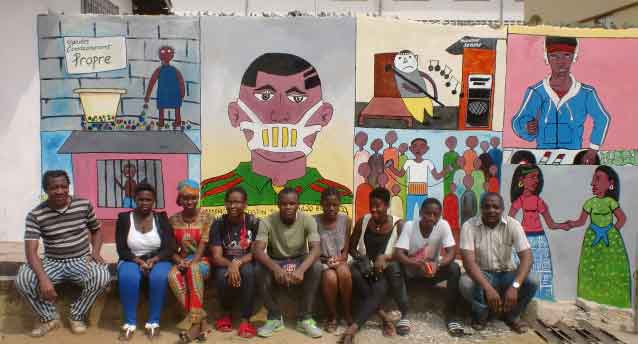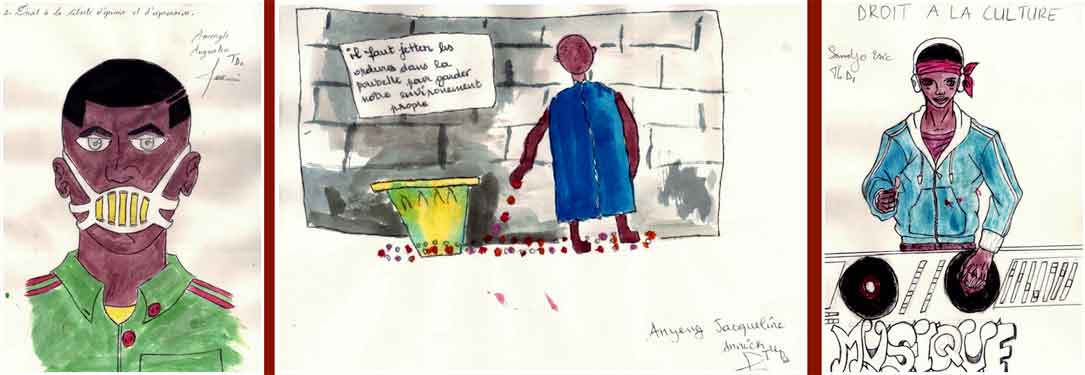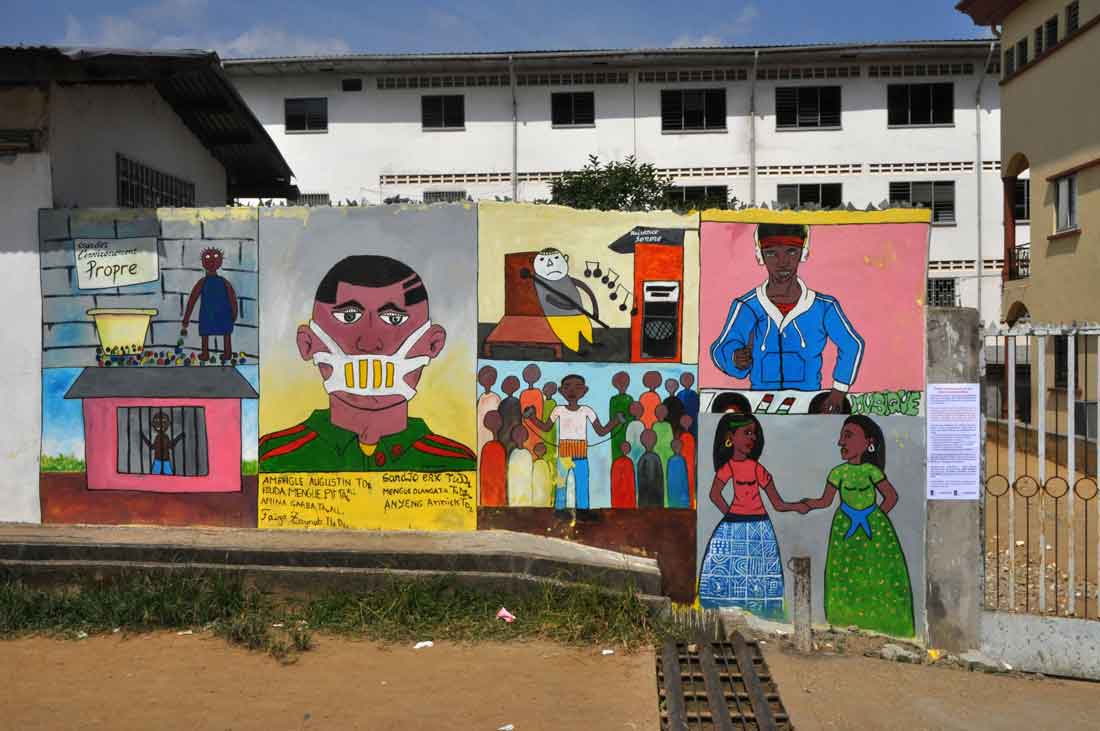By Princess Marilyn Douala Manga Bell & Kornelia Freier (May 2025)
Abstract
This chapter documents an art education program by doual'art in Cameroon. Based on an exhibition about the country's history, students in Douala, the largest city in Cameroon, developed murals in public spaces. These murals address current human rights issues in Cameroon. A traveling exhibition on colonialism in Cameroon was created to accompany the content of the program.

Fig 1: Students in fromt of their mural (Courtesy of doual'art)
doual'art as initiator of the project
The Centre for Contemporary Art doual'art (http://doualart.org/) was founded in 1991 as a non-profit cultural organization by Princess Marilyn Douala Manga Bell and Didier Schaub in Douala, Cameroon. Douala is the largest city in the country with a population of almost three million. doual'art is one of the most important centers for contemporary art in the country.
doual'art is also dedicated to the promotion of culture in the city of Douala. Its main focus is on urban and cultural development: art projects, exhibitions and support for young local artists. In this way, the social, political and economic challenges of the region are jointly reflected upon and the dialog between the citizens and the city is promoted and interventions in the socio-cultural space of the city are initiated. In a dialog between the community and artists, issues such as identity, history and the future of the African metropolis of Douala are addressed. In addition, doual'art has been working intensively for several years on the reappraisal of Cameroon's colonial history.
Historical background
The project presented here has a reference to Cameroon's colonial history. Taking a look at the history of Cameroon, it becomes clear that the borders of today's Cameroon were created arbitrarily in the course of colonization by the German Empire from 1884 onwards. This resulted in widespread violence, displacement and serious human rights violations. The king at the time, Duala Manga Bell, rebelled and organized resistance. In 1914, he was hanged by the German colonial rulers. After the First World War and the subsequent end of German colonial policy, Cameroon was divided into two mandated territories of different sizes, with the largest part going to France and a smaller part to Great Britain. The arbitrary demarcation of the borders in 1884 and the subsequent equally arbitrary division led to great tensions. The introduction of English or French as the respective official language intensified the internal division in the country.
This is one of the reasons why, since 2016, Cameroon has repeatedly experienced serious political crises. They began with a strike against the structural discrimination of the two Anglophone regions by the Francophone-dominated central government. As a result, Anglophone Cameroonians have increasingly turned away from the French-dominated nation state, while identification with the multi-ethnic, multicultural, multi-religious and multilingual state and its institutions is clearly on the decline.
Both Anglophone and Francophone Cameroonians are hardly aware of the shared and at the same time divisive history, as the education system and historiography are still strongly influenced by colonialism: Students often learn more about European history than about Cameroonian history.
It is therefore important to talk about what unites and divides people in Cameroon today - across linguistic and ethnic boundaries. Artistic approaches that emphasize the common cultural heritage can create spaces for dialogue and thus contribute to conflict prevention. The medium of art makes it possible to address difficult topics - such as coming to terms with the colonial era - and to deal with them creatively. But there is a lack of spaces for cultural or artistic expression - especially for young people. Art is generally not taught in schools. This makes the work of doual'art so important.
The project
One project in this context was the development of a traveling exhibition with photos, texts and historical documents documenting the biographies of Cameroonian and German actors during the colonial period. This exhibition was shown in several project schools with the aim of discovering the history of Cameroon. In order to help overcome the conflicts mentioned above, the aim was to strengthen the formation of a common identity based on one's own history. There were also interactive activities and a concluding workshop with historians.
For the second phase, interested pupils aged 8-17 were invited to take part in three-day creative workshops to explore the themes of the exhibition artistically. This took place outside the classroom. They were first asked to identify the areas in which law and lawlessness prevailed during the colonial period. This question ultimately brought the Universal Declaration of Human Rights into play, which from then on formed the normative framework for the project. The students then wrote down the topics they wanted to work on artistically.

Fig 2: Sketches by the students (Courtesy of doual'art)
The students now specifically observed situations in their everyday lives that could be relevant in the context human rights. They sketched their observations in drawings (see fig. 2). Individual works were then selected. They served as drafts for the murals, which were then realized in collaboration with artists. The medium of the mural was chosen in order to bring the issue into the public sphere and to further stimulate the discourse.
The students had been unfamiliar with the artistic means used. They were therefore amazed at what they were able to achieve. Initially, they had no idea that they would be able to produce a drawing or even a mural. Perhaps this is why the project attracted the attention of other head teachers and teachers. They approached us to ask if their children could also come to these workshops. Many students who were not interested at first also asked to join us next time.

Fig 3: Mural designed by the students in Douala 2024 (Courtesy of doual'art)
Conclusion
"We speak about representation of the reality as a mirror in such a way that we have this possibility to reconsider our life, the way we move in the city, the relationship we have with the others. And art is - sometimes the artists don't like to hear that because they are afraid of being instrumentalized - but art is a kind of tool to make us able to speak differently, or to look differently in their life. I speak about the way people feel themselves. Often, they don't like their life, they don't like who they are. They were educated from this colonial period that being black is nothing. And it's very important that art made people have a better way of feeling, of looking at themselves." (Princesse Marilyn Douala Manga Bell, Director of doual'art, in an interview from September 2024 - https://www.dw.com/en/how-quane-martin-dibobe-challenged-german-colonialism/video-68258230)

Fig 4: Mural designed by the students in Douala 2024 (Courtesy of doual'art)
Published in May 2925
